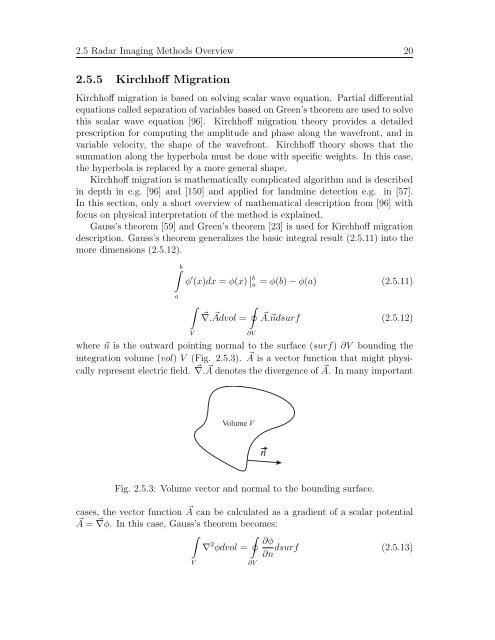Through-Wall Imaging With UWB Radar System - KEMT FEI TUKE
Through-Wall Imaging With UWB Radar System - KEMT FEI TUKE
Through-Wall Imaging With UWB Radar System - KEMT FEI TUKE
Create successful ePaper yourself
Turn your PDF publications into a flip-book with our unique Google optimized e-Paper software.
2.5 <strong>Radar</strong> <strong>Imaging</strong> Methods Overview 20<br />
2.5.5 Kirchhoff Migration<br />
Kirchhoff migration is based on solving scalar wave equation. Partial differential<br />
equations called separation of variables based on Green’s theorem are used to solve<br />
this scalar wave equation [96]. Kirchhoff migration theory provides a detailed<br />
prescription for computing the amplitude and phase along the wavefront, and in<br />
variable velocity, the shape of the wavefront. Kirchhoff theory shows that the<br />
summation along the hyperbola must be done with specific weights. In this case,<br />
the hyperbola is replaced by a more general shape.<br />
Kirchhoff migration is mathematically complicated algorithm and is described<br />
in depth in e.g. [96] and [150] and applied for landmine detection e.g. in [57].<br />
In this section, only a short overview of mathematical description from [96] with<br />
focus on physical interpretation of the method is explained.<br />
Gauss’s theorem [59] and Green’s theorem [23] is used for Kirchhoff migration<br />
description. Gauss’s theorem generalizes the basic integral result (2.5.11) into the<br />
more dimensions (2.5.12).<br />
�b<br />
a<br />
φ ′ (x)dx = φ(x) � �b a = φ(b) − φ(a) (2.5.11)<br />
�<br />
V<br />
�∇. � �<br />
Advol =<br />
∂V<br />
�A.�ndsurf (2.5.12)<br />
where �n is the outward pointing normal to the surface (surf) ∂V bounding the<br />
integration volume (vol) V (Fig. 2.5.3). � A is a vector function that might physically<br />
represent electric field. � ∇. � A denotes the divergence of � A. In many important<br />
Volume V<br />
Fig. 2.5.3: Volume vector and normal to the bounding surface.<br />
cases, the vector function � A can be calculated as a gradient of a scalar potential<br />
�A = � ∇φ. In this case, Gauss’s theorem becomes:<br />
�<br />
∇ 2 �<br />
∂φ<br />
φdvol = dsurf (2.5.13)<br />
∂n<br />
V<br />
∂V<br />
n








